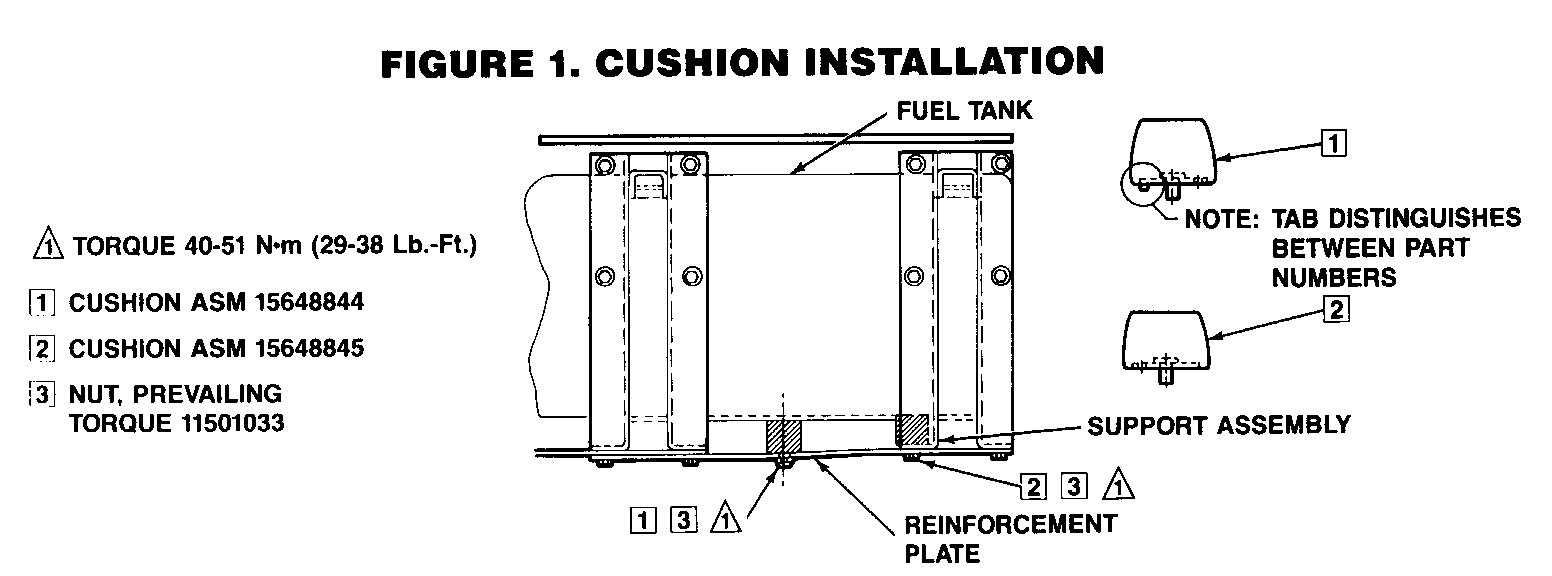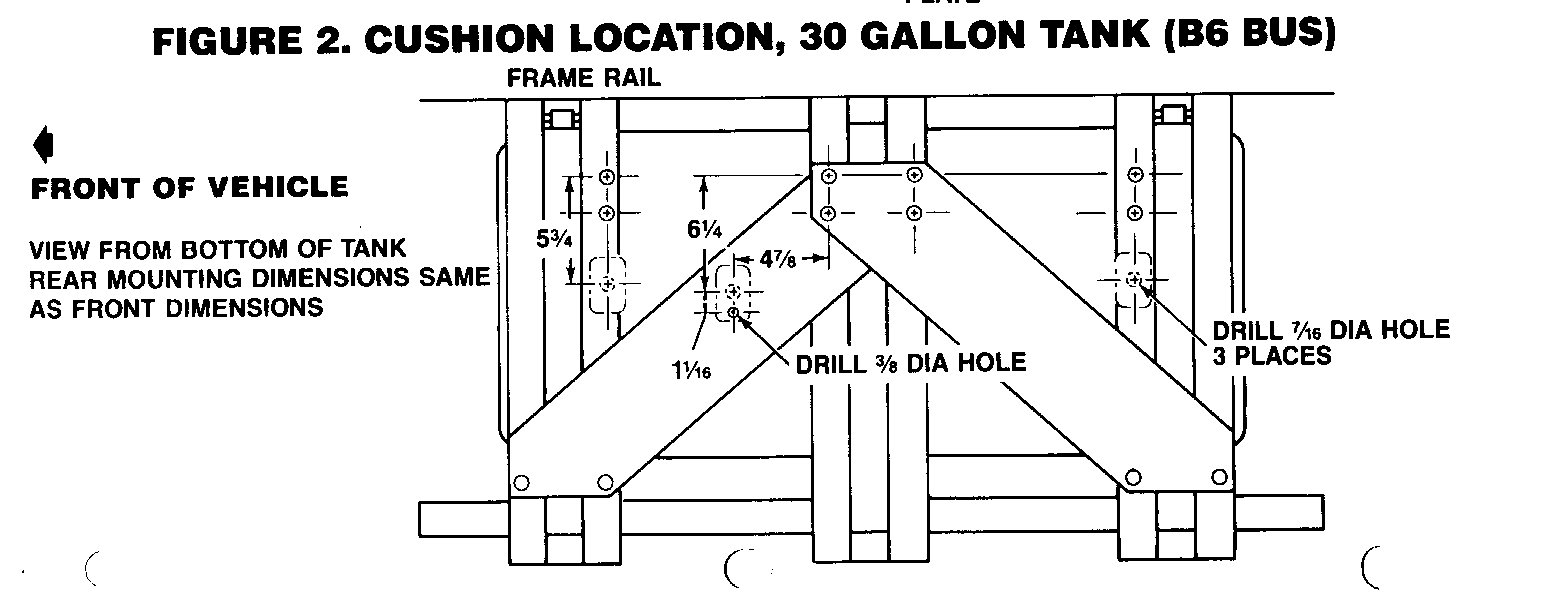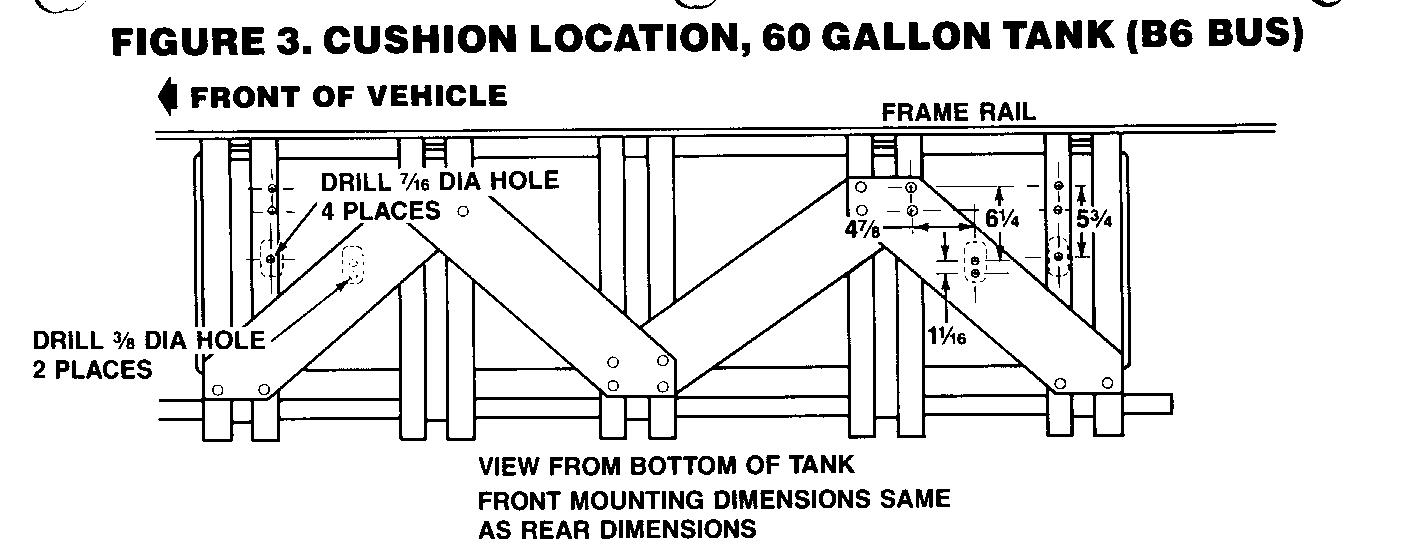CAMPAIGN: FUEL TANK LEAK NEW TANK & CUSHION MOUNTS

SUBJECT: GASOLINE TANKS LEAK
MODELS: 1986-1989 B6P042 & S7T042 SCHOOL BUS CHASSIS WITH GASOLINE ENGINES LF5 (5.7L), L86 (6.0L) OR LSO (6.0L TBI)
The National Traffic and Motor Vehicle Safety Act, as amended, provides that each vehicle which is subject to a recall campaign of this type must be adequately repaired within a reasonable time after the owner has tendered it for repair. A failure to adequately repair within 60 days after tender of a vehicle is prima facie evidence of failure to repair within a reasonable time.
If the condition is not adequately repaired within a reasonable time, the owner may be entitled to an identical or reasonably equivalent vehicle at no charge, or to a refund of the purchase price less a reasonable allowance for depreciation.
To avoid having to provide these burdensome solutions, every effort must be made to promptly schedule appointments with owners and to repair their vehicles as soon as possible. As you will see in reading the attached copy of the letter which is being sent to owners, the owner is being instructed to contact the nearest GMC Zone Office if the dealer does not remedy the condition within five days of the mutually agreed upon service date. If the condition is not remedied within a reasonable time, they are instructed how to contact the National Highway Traffic Safety Administration.
DEFECT INVOLVED
General Motors has determined that a defect which relates to motor vehicle safety exists in certain 1986-1989 B6/S7 School Bus chassis. A crack adjacent to the fuel tank seam weld attaching the tank end cap may develop. This crack can manifest itself as either a damp spot on the tank or a slight dripping. It was determined that the seam cracks were caused by oil canning of the bottom of the fuel tank.
To correct this condition, it will be necessary to install cushion mounts on the tank support brackets. Additionally, the fuel tank will be inspected for cracks and replaced if necessary. It is estimated that approximately 5% of involved school buses will require fuel tank replacement due to seam cracking.
VEHICLES INVOLVED
Involved are certain 1986-1989 B6P042 and S7T042 School Bus chassis with gasoline engines LF5, L86 or LSO and built within the following VIN breakpoints:
MODEL YEAR MODEL FROM THROUGH ---- ------------- ---- -------- 1986 GMC/Chevrolet SOP EOP 1987 GMC/Chevrolet SOP EOP 1988 GMC/Chevrolet SOP EOP 1989 GMC SOP KV517539 Chevrolet SOP KV112137
The specific vehicles involved in this campaign have been identified by Vehicle Identification Number Computer Listings. These listings are fur- nished to all involved dealers with the campaign bulletin.
DEALER CAMPAIGN RESPONSIBILITY
Dealers are to service all vehicles subject to this campaign at no charge to owners, regardless of mileage, age of vehicle, or ownership, from this time forward. Dealers are to correct all affected vehicles in new and used vehicle stock prior to their sale.
Whenever a vehicle subject to this campaign is taken into your new or used vehicle inventory, or it is in your dealership for service in the future, you should take the steps necessary to ensure the campaign correction has been made before reselling or releasing the vehicle.
Owners of vehicles recently sold from your new vehicle inventory are to be contacted by the dealer and arrangements made to make the required cor- rection according to instructions contained in this bulletin.
If no owner's name and address were available to GMC Truck Division at the time of campaign initiation, the dealer will determine the owner's name and address from the dealership sales records. Please provide this information directly on the second copy of the listing next to the applicable VIN so that our records may be updated and the appropriate notification mailed to the owner. This second copy should then be submitted to the address listed below in the previously supplied yellow campaign envelopes.
GMC Truck Division General Motors Corporation 101 Union Street Plymouth, Michigan 48170
OWNER NOTIFICATION
Owners will be notified of this campaign on their vehicles by GMC Truck Division (see copy of owner letter included with this bulletin). A listing of owner names and addresses has been furnished to the involved dealers to enable dealers to follow up with owners involved in this campaign. This listing may contain owner names and addresses obtained from State Motor Vehicle Registration records. The use of such motor vehicle registration data for any other purpose is a violation of law in several states. Ac- cordingly, you are urged to limit the use of this listing to this campaign.
SERVICE PROCEDURE
A. INSPECTION OF FUEL TANKS FOR CRACKS/FUEL LEAKAGE
Prior to installing cushion mounts, the existing fuel tank on the vehicle must be inspected to determine if the tank has developed leaks at the seams on the ends of the tank. If cracks are found, the tank must be replaced. See Section C for instructions on tank removal and re- placement. The tank should be inspected carefully, as leakage may be hard to detect. It may be necessary to clean the seams of all dirt and other contaminants that can obscure leakage detection. Proceed to Section B.
B. INSTALLATION OF CUSHION MOUNTS (FIGURE #1)
If inspection reveals no leaks or new fuel tank installation is required due to leakage, cushion mounts must be installed between the fuel tank and the tank mounting brackets and reinforcements. Three (3) cushions are required for 30-gallon tanks and four (4) are required for 60-gallon tanks.
1. Block wheels and apply brakes.
2. Disconnect negative battery cable.
3. Remove nuts and washers from tank holddown straps (2 straps for 30-gallon tanks and 4 straps for 60-gallon tanks). Pull straps to a loose position.
4. Place floor jack under tank. Install a wooden block on jack to protect tank.
5. Jack tank up dear of support assembles sufficiently to allow installation of cushion assemblies (approximately 2-1/4 inches).
6. Drill cushion mounting holes (7/16" diameter) in two support assemblies. See Figures #2, #3 and #4 for location of holes for each type of tank. A template has been supplied to locate the holes. De-burr holes to allow cushions to completely seat.
7. Drill cushion mounting holes (one 3/8" diameter and one 7/16" diameter) in two reinforcements for 60-gallon tanks and one reinforcement for 30-gallon tanks. See Figures #2, #3, and #4 for location of holes for each type of tank. The template described in Step 6 locates these holes also. De-burr holes to allow cushions to completely seat.
8. Install cushion assemblies in position and torque down nuts to 40-51 Nm (29-38 lb ft). (See Figure #1)
NOTE: The tank can be balanced on the jack to gain extra installation room. If space problem still exists, the reinforcement bolts may need to be loosened or removed to install cushions.
9. Lower fuel tank onto cushion assemblies.
10. Reinstall nuts and washers on tank holddown straps. Torque nuts to 39-50 Nm (29-37 lb ft).
11. Check vent hose connections.
C. FUEL TANK REMOVAL AND INSTALLATION (FIGURE #5)
It is recommended that vehicle front and rear tires be driven up on 2-inch or 4-inch blocks to facilitate removal and sliding tank out from under the vehicle body. Otherwise, clearance will be marginal.
1. Disconnect battery ground cable.
2. Drain the fuel. Refer to service manual for proper procedures and precautions. Tank must be empty of all fuel to allow safe and easy removal.
3. Remove fuel line brackets, tie straps, and grommets in frame at fuel sender location.
NOTE: On vehicles with in-tank fuel pumps, fuel lines are connected with threaded fittings and cannot be pulled through frame. Tank must be partially lowered first, before fittings can be accessed and disconnected.
4. Pull lines through frame until clamps are accessible. Remove clamps and disconnect hoses.
5. Install a jack and wooden blocks under tank for support. Center tank properly for balance on the jack.
6. Remove and retain the four (4) nuts, bolts, and washers holding the horizontal mounting struts to the frame at the front and rear of the tank.
7. Remove and retain the four (4) nuts, bolts, and washers holding the fuel tank mounting brackets to the frame. There are three brackets for the 30-gallon tank and five brackets for the 60-gallon tank. Remove vent valve bracket with the front mounting bracket.
8. Lower tank sufficiently to gain access to fuel sender unit.
9. Disconnect fuel sender unit and fuel pump feed wires at tank unit. Also disconnect fuel line fittings if they could not be removed in Step 4.
10. Slide fuel tank outboard from frame for access to fuel sender unit and vent lines.
11. Remove fuel tank mounting straps.
12. Replace fuel tank.
13. Install cushions on supports and reinforcements. Refer to Section B, Steps 6 thru 8 for procedures.
14. If tank is to be replaced, remove sender by removing seven (7) mounting screws from sender. Retain screws.
15. Remove sender and gasket and discard gasket. Also remove vent lines, fittings, valve, and fuel cap.
16. Clean gasket mounting area on new tank thoroughly and install new gasket. Reinstall sender and mounting screws.
17. Reinstall vent lines, fittings, valve, and fuel cap. Apply sealer to fitting threads before installation.
18. Reconnect sender and fuel pump connectors on engine harness to sender connectors.
19. Reinstall mounting straps and torque nuts to 39-50 Nm (29-37 lb ft).
20. Center tank in proper mounting position before rolling it back under vehicle.
21. Jack up tank and mounting brackets to proper height for mounting.
22. Reconnect fuel lines, fuel line bracket, and reinstall grommets.
23. Re-attach mounting support brackets and horizontal struts to frame with existing hardware. Torque nuts to 61-68 Nm (44-50 lb ft).
PARTS INFORMATION
Parts are to be obtained from General Motors Service Parts Operation (GMSPO). To ensure that these parts will be obtained as soon as possible, they should be ordered from GMSPO on a C.I.O. order with no special instruction code but order under an advise code (2).
The following parts are required on ALL involved vehicles:
PART NUMBER DESCRIPTION QUANTITY -------- -------------- ------------------- 15648845 Cushion, Outer 2 With 60 Gal. Tank 2 With 30 Gal. Tank
15648844 Cushion, Inner 2 With 60 Gal. Tank 1 With 30 Gal. Tank
11501033 PTN 4 With 60 Gal. Tank 3 With 30 Gal. Tank
The following parts are "AS REQUIRED" and should be ordered accordingly:
PART NUMBER DESCRIPTION QUANTITY -------- --------------------- --------- 15617723 Fuel Tank, 60 Gal. AR (California Emissions YF5)
15617724 Fuel Tank, 60 Gal. AR (Federal Emissions NA5)
15617725 Fuel Tank, 30 Gal. AR (Federal Emissions NA5)
15617726 Fuel Tank, 30 Gal. AR (California Emissions YF5)
22515965 Gasket, Fuel Gage AR
WARRANTY INFORMATION
Dealers should submit an accurately filled out Warranty Repair Order on each vehicle completed under this campaign.
LABOR OPERATION *TIME TROUBLE NUMBER DESCRIPTION ALLOWANCE CODE --------- ----------------------------- --------- -------- Inspect Fuel Tank for Cracks - No Cracks, Install Cushions
V5390 60 Gal. Tank .9 Hr 96 V5391 30 Gal. Tank .9 Hr 96
Inspect Fuel Tank for Cracks - Cracks Found, Install New Tank and Cushions
V5392 60 Gal. Tank 3.4 Hr 96 V5393 30 GW. Tank 2.8 Hr 96
* For dealer to receive Administrative Time Allowance associated with this campaign, add 0.1 hour to the Labor Operation Time Allowance.
CAMPAIGN IDENTIFICATION LABEL
Each vehicle corrected in accordance with the instructions outlined in this product campaign bulletin will require a "Campaign Identification Label." Each label provides a space to include the five (5) digit dealer code of the dealer performing the campaign service. This information may be inserted with a typewriter or ball point pen.
Each "Campaign Identification Label" is to be located on the radiator core support in an area which will be visible when the vehicle is brought in for periodic servicing by the owner.
Apply "Campaign Identification Label" only on a clean, dry surface.
ADMINISTRATIVE PROCEDURE
Procedures covering this campaign are outlined in Section V of your dealership's "GM Truck Claims Processing Manual" #P 8819.
Dear GM Owner:
This notice is sent to you in accordance with the requirements of the National Traffic and Motor Vehicle Safety Act.
General Motors has determined that a defect which relates to motor vehicle safety exists in certain 1986-1989 B6/S7 School Bus chassis. A crack adjacent to the fuel tank seam weld attaching the tank end cap may develop. This crack can manifest itself as either a damp spot on the tank or a slight dripping. It was determined that the seam cracks were caused by oil canning of the bottom of the fuel tank.
To correct this condition, it will be necessary to install cushion mounts on the tank support brackets. Additionally, the fuel tank will be inspected for cracks and replaced if necessary. It is estimated that approximately 5% of involved school buses will require fuel tank replacement due to seam cracking. This service will be performed for you at no charge.
Instructions for performing this service have been sent to your GM dealer. Parts are available. Please contact your dealer to arrange a service date. The labor time necessary to perform this correction may vary from 1 hour to 3-1/2 hours. Please ask your dealer how much additional time will be needed to process your vehicle.
Your GM dealer is best equipped to obtain parts and provide service to ensure your vehicle is corrected as promptly as possible. However, if you take your vehicle to your dealer on the agreed service date and they do not service this condition on that date or within five days, we recommend you contact your nearest GMC Truck Zone Office by telephone. The Zone Office will assist you and your dealer in getting your vehicle corrected. The telephone numbers of the Zone Offices are listed in your Warranty and Owner Assistance Information Manual.
After contacting your dealer and the Zone Office, if you are still not satisfied that we have done our best to remedy this condition without charge within a reasonable time, you may wish to write the Administrator, National Highway Traffic Safety Administration, 400 Seventh Street, S.W., Washington, D.C. 20590, or call 800-424-9393 (Washington, D.C. residents use 366-0123).
The endosed owner reply card identifies your vehicle. Presentation of this card to your dealer will assist in making the necessary correction to your vehicle in the shortest possible time. If you have sold or traded your vehicle, please let us know by completing the postage paid owner reply card and returning it to us. We are sorry to cause you this inconvenience; however, we have taken this action in the interest of your safety and continued satisfaction with our products.





General Motors bulletins are intended for use by professional technicians, not a "do-it-yourselfer". They are written to inform those technicians of conditions that may occur on some vehicles, or to provide information that could assist in the proper service of a vehicle. Properly trained technicians have the equipment, tools, safety instructions and know-how to do a job properly and safely. If a condition is described, do not assume that the bulletin applies to your vehicle, or that your vehicle will have that condition. See a General Motors dealer servicing your brand of General Motors vehicle for information on whether your vehicle may benefit from the information.
